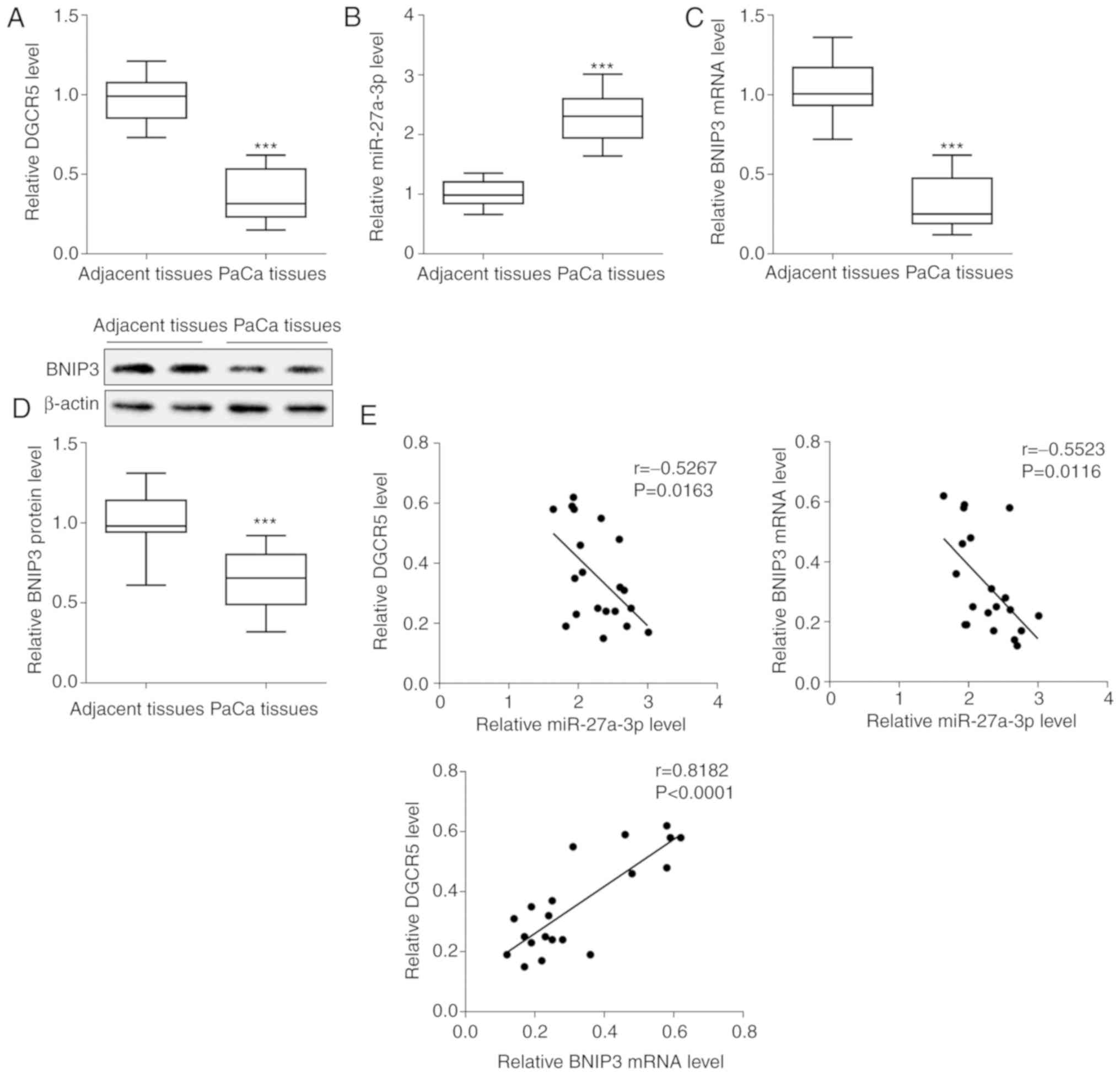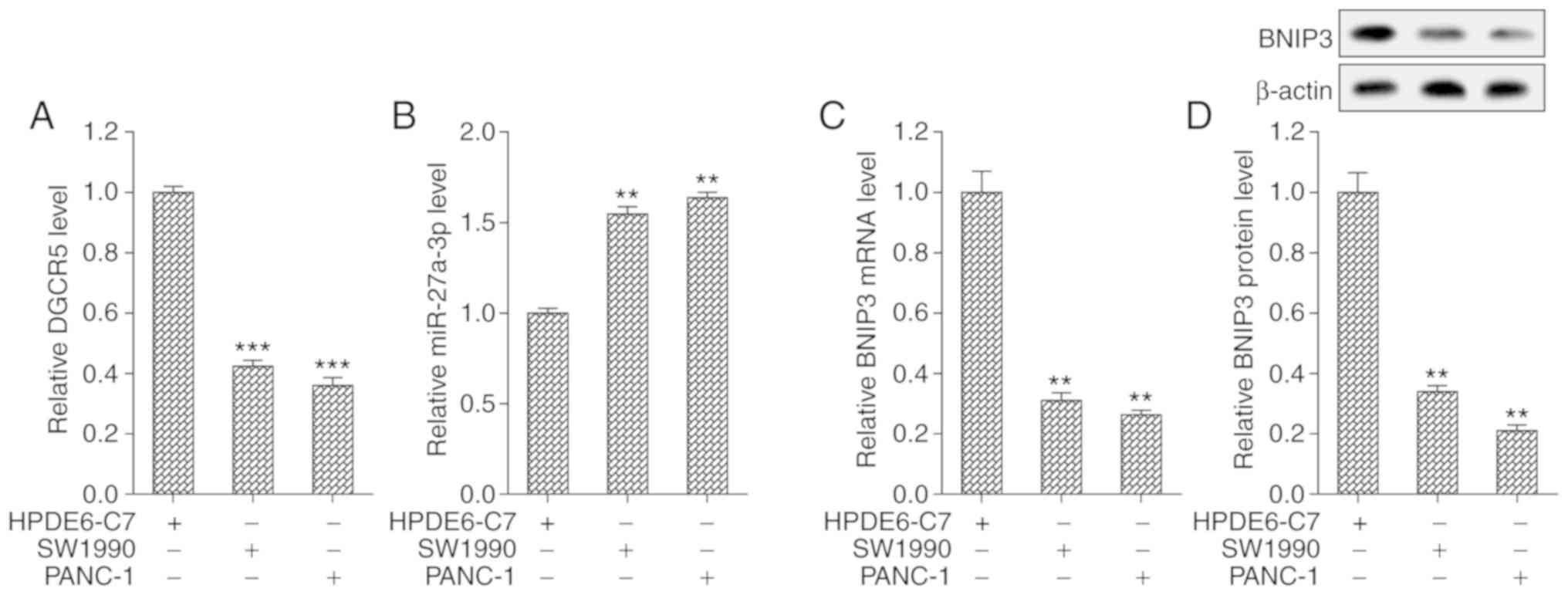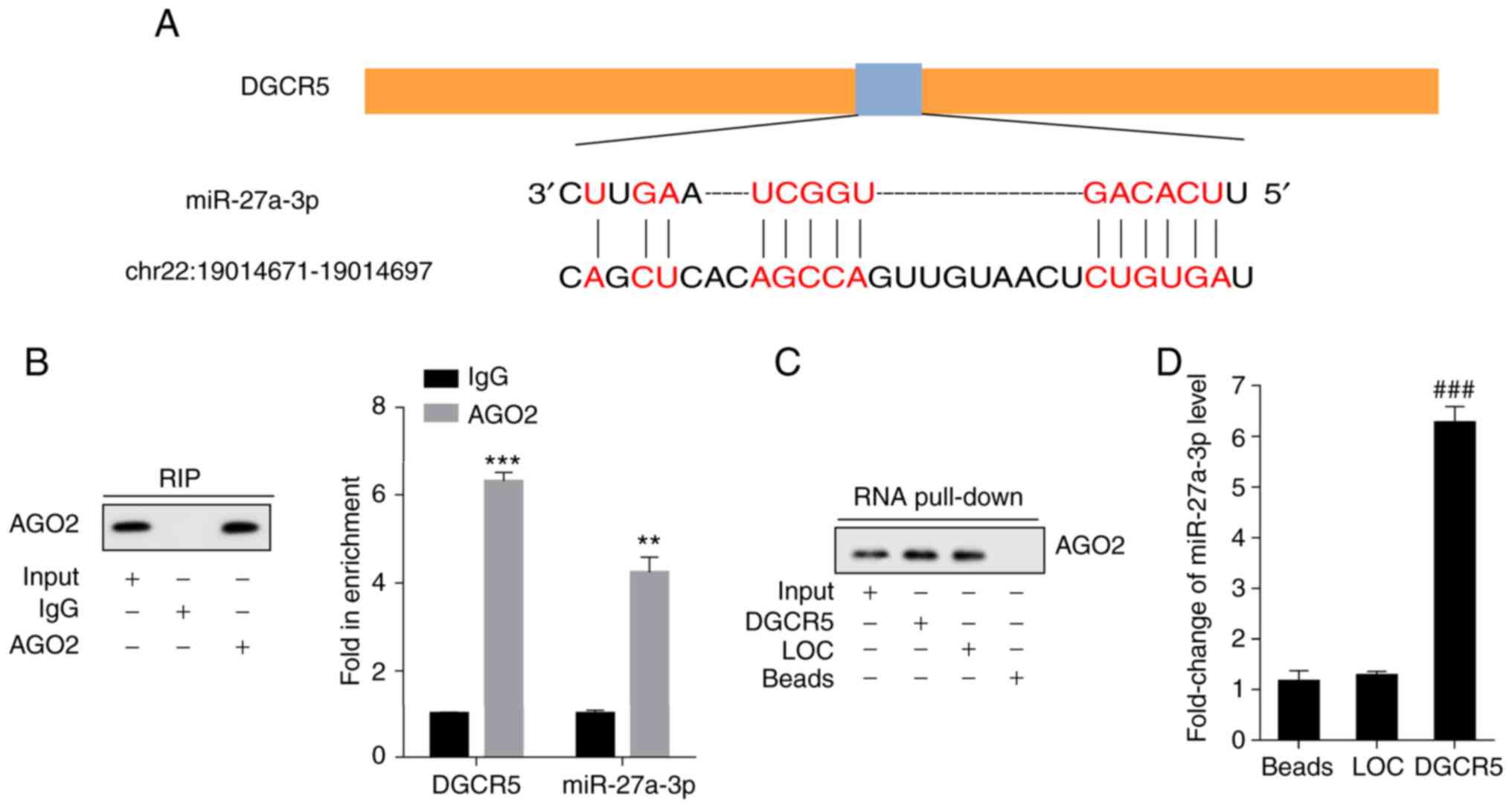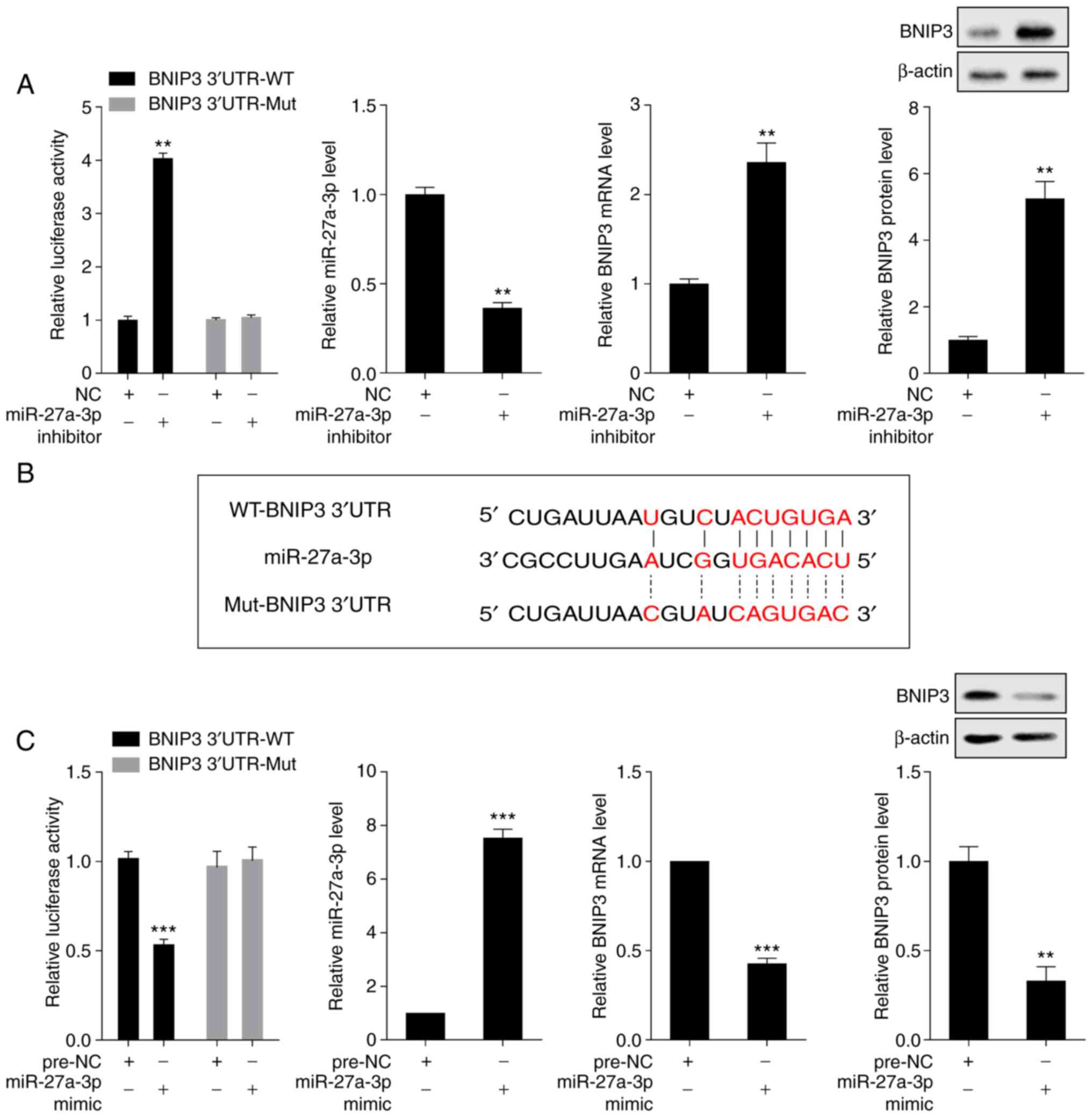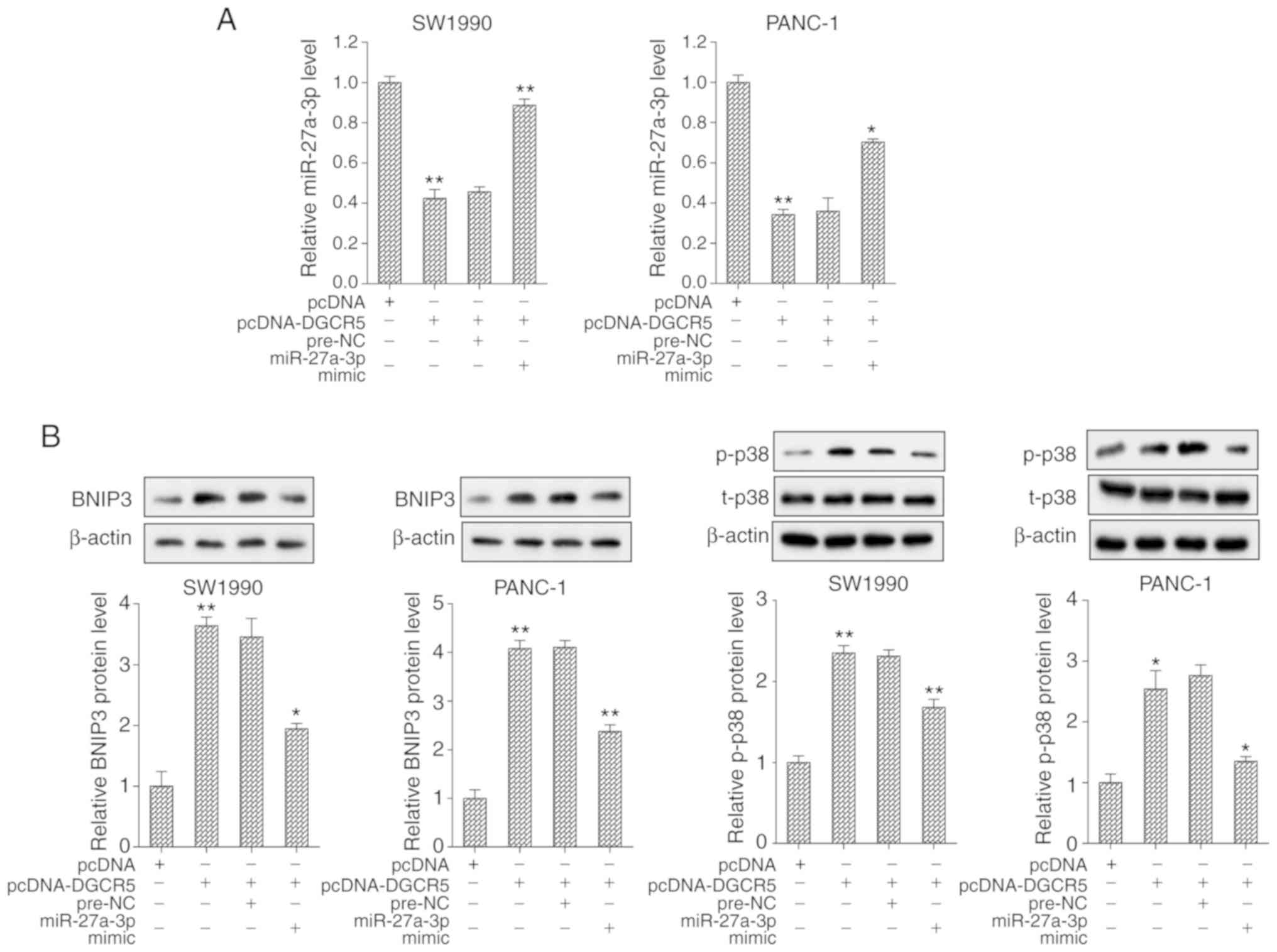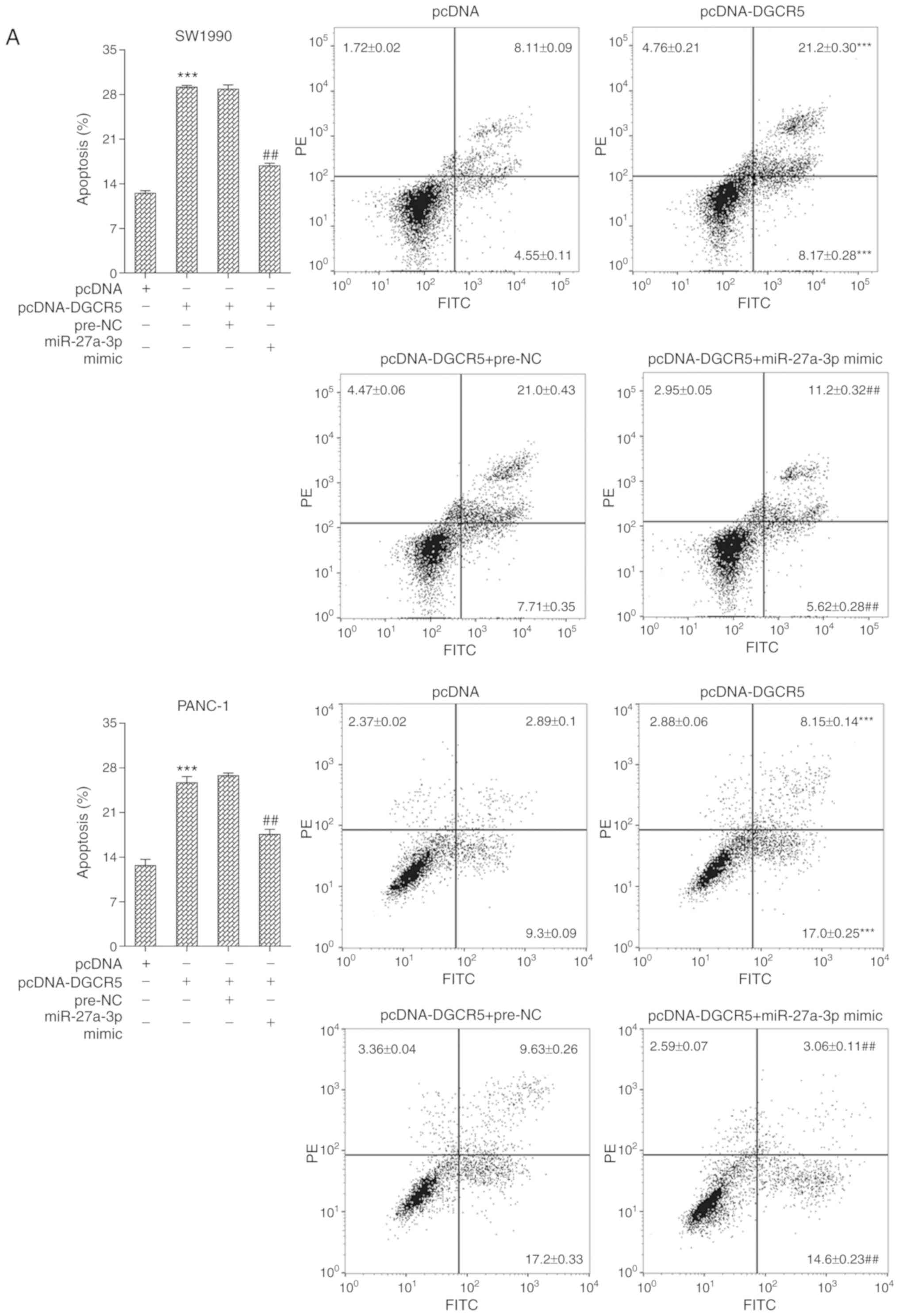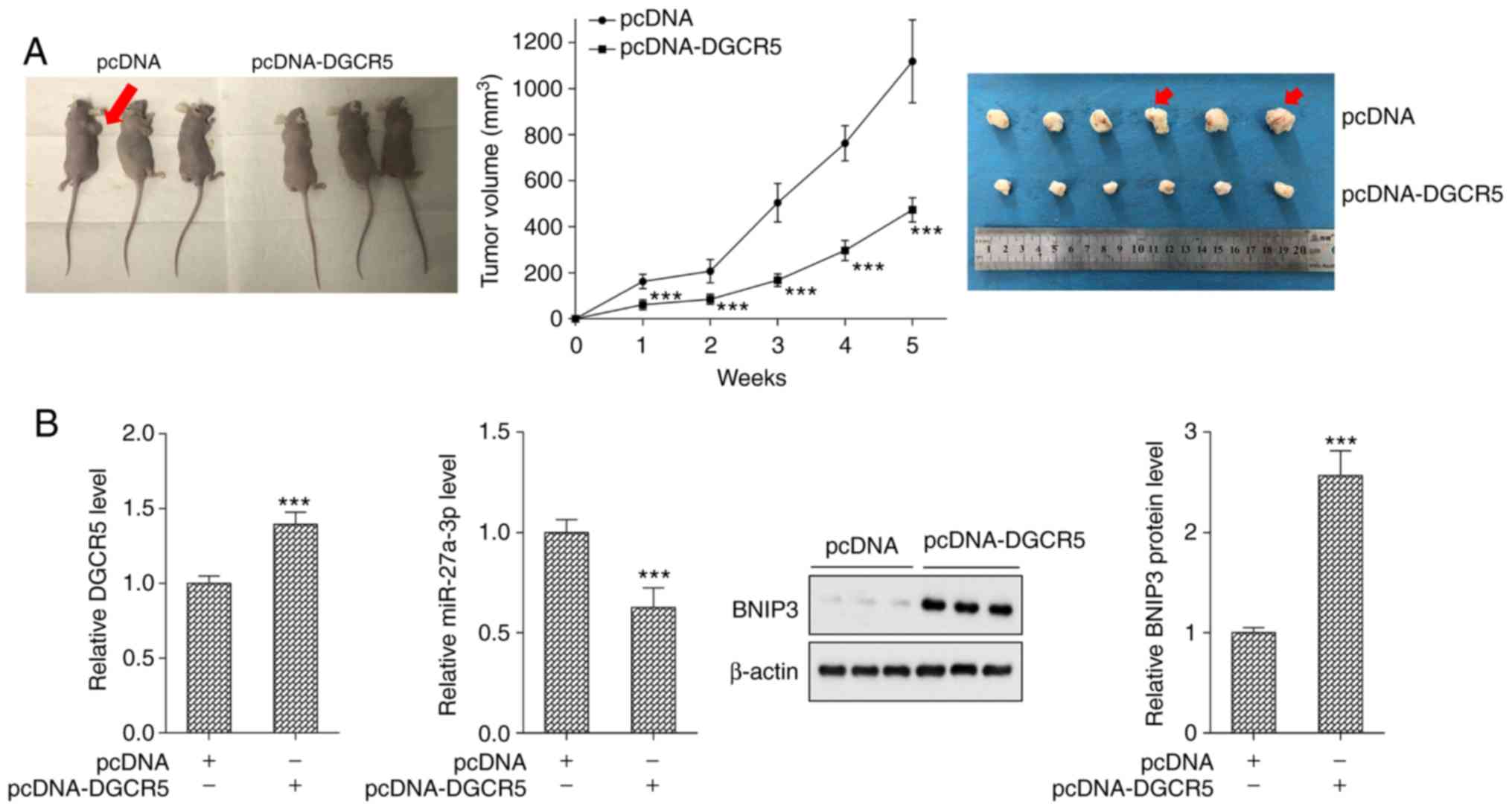lncRNA DGCR 5/miR‑27a‑3p/BNIP3 promotes cell apoptosis in pancreatic cancer by regulating the p38 MAPK pathway
- Authors:
- Published online on: June 4, 2020 https://doi.org/10.3892/ijmm.2020.4632
- Pages: 729-739
-
Copyright: © Li et al. This is an open access article distributed under the terms of Creative Commons Attribution License.
Abstract
Introduction
Pancreatic cancer (PaCa) is gastrointestinal type of cancer with a very high malignancy and is one of the leading causes of cancer-related mortality worldwide (1). Due to the high recurrence rate and rapid tumor growth, the prognosis of patients with PaCa is poor, and the 5-year survival rate is as low as 10% (2), which is a major obstacle towards the improvement of patient survival. Previous studies have demonstrated that the loss or low expression of Bcl-2/adenovirus E1B-19kDa-interacting protein 3 (BNIP3) in PaCa leads to chemotherapeutic resistance and a worse prognosis (3,4). BNIP3 is a member of the Bcl-2 family and has the potential to facilitate cell apoptosis and evoke cell death and autophagic cell death. Recently, it has been demonstrated that BNIP3 is regulated by p21 and induces cell cycle arrest and cell apoptosis in PaCa (5) and that BNIP3 participates in cell apoptosis via the modulation of the activation of the 5′ AMP-activated protein kinase (AMPK) pathway (6). A previous study reported that mitogen-activated protein kinase (MAPK) was involved in the cell apoptosis of PaCa, suggesting its association with PaCa progression (7).
Moreover, bioinformatics software have predicted the complementary base pairs between miR-27a-3p and BNIP3, suggesting a potential binding site between them. MicroRNAs (miRNAs or miRs) are a type of non-coding RNA (of approximately 22 nucleotides) that negatively regulate gene expression in various biological processes, and the dysregulation of miRNAs has been implicated in numerous human disorders (8). For instance, miR-27a has been shown to be aberrantly expressed in several types of cancer. As previously reported, the expression of miR-27a is associated with clinical pathological parameters, including tumor size, lymph node metastasis and distant metastasis in breast cancer; further-more, a high expression of miR-27a is related to poor the overall survival of patients with breast cancer (9). In addition, the downregulation of miR-27a has been shown to suppress cell growth and migration in PaCa (10). The expression of miR-27a-3p in peripheral blood mononuclear cells (PBMCs) has also been demonstrated to be a potential marker for PaCa screening, serving as a promising strategy for the accurate diagnosis of this disease (11).
As an identified tumor suppressor, lncRNA DGCR5 has been revealed to be downregulated in hepatocellular carcinoma and lung cancer, and the overexpression of DGCR5 contributes to the repression of cell proliferation, migration and invasion, and promotes the cell apoptosis of these cancers (12,13). Regrettably, the role of DGCR5 in PaCa has not been focused on and explored yet. The prediction of complementary base pairs between DGCR5 through bioinformatics analysis has been a breakthrough, and it indicates the potential binding and targeting effects between them. Therefore, it was hypothesized that lncRNA DGCR5 may also play an important role in the progression of PaCa by interacting with miR-27a-3p and that miR-27a-3p may also affect the growth or development of PaCa by targeting BNIP3, a hypothesis which is explored in the present study.
Materials and methods
Clinical samples
The present study was approved by the Medical Ethics Committee of the Affiliated Hospital of Medical School, Ningbo University. All the patients agreed and signed the documented informed consent for tissue donation for study prior to sample collection.
PaCa tissues and adjacent normal tissues (n=20) were obtained from patients with PaCa in the Affiliated Hospital of Medical School, Ningbo University, and the clinical and pathological characteristics of the patients are depicted in Table I. The tissue samples were frozen in liquid nitrogen and immediately stored at -80°C prior to analysis.
RNA extraction and reverse transcription-quantitative PCR (RT-qPCR)
Total RNA was isolated from PaCa and adjacent tissues and cell lines using TRIzol reagent (Invitrogen; Thermo Fisher Scientific, Inc.) according to the manufacturer's standard procedures. The reverse transcription of total RNA was performed using the cDNA Reverse Transcription kit (Applied Biosystems) to synthesize cDNA. Quantitative PCR was performed on an ABI Prism 7900HT system (Applied Biosystems) with the SYBR Select Master Mix (Applied Biosystems) to quantify gene expression. Primers were synthesized with Sangon Biotech. β-actin and U6 served as endogenous controls. Finally, the 2−∆∆Cq method was used to determine the relative expression levels (14). The primer sequences were as follows: DGCR5 forward, 5′-CAC GAG TGT AGT GCC CAG TT-3′ and reverse, 5′-GGT CAG GGA CCT TTG TCG TT-3′; miR-27a-3p forward, 5′-GGC TTA GCT GCT TGT GA-3′ and reverse, 5′-GAA CAT GTC TGC GTA TCT C-3′; BNIP3 forward, 5′-GCC CAC CTC GCT CGC AGA CAC-3′ and reverse, 5′-CAA TCC GAT GGC CAG CAA ATG AGA-3′; β-actin forward, 5′-AAG TAC TCC GTG TGG AT C GG-3′ and reverse, 5′-ATG CTA TCA CCT CCC CTG TG-3′; and U6 forward, 5′-CTC GCT TCG GCA GCA CA-3′ and reverse, 5′-AAC GCT TCA CGA ATT TGC GT-3′. The PCR thermocycling conditions were as follows: PCR reactions were carried out for 40 cycles that comprised a denaturation step at 95°C for 15 sec, an annealing step at 62°C for 45 sec and an extension step at 72°C for 30 sec.
Western blot analysis
Western blot analysis was performed to examine the protein levels. The tissues and cells were lysed in lysis buffer (Beyotime Institute of Biotechnology) containing protease inhibitors. The protein concentration was measured using a Bradford protein assay kit (Bio-Rad Laboratories, Inc.), and the proteins were then separated by 10% SDS-PAGE with an electrophoresis system (Bio-Rad Laboratories, Inc.). Following separation, the proteins were transferred to a poly-vinylidene difluoride (PVDF) membrane (Invitrogen; Thermo Fisher Scientific, Inc.). After blocking in Tris-buffered saline (TBS) containing 5% skimmed milk for 1 h at room temperature, the membrane was incubated with primary antibodies against BNIP3 (1:500, sc-56167; Santa Cruz Biotechnology, Inc.), p-p38 (1:1,000, 4511; Cell Signaling Technology, Inc.), p38 (1:1,000, 8690; Cell Signaling Technology, Inc.), Bcl-2 (1:1,000, 15071; Cell Signaling Technology, Inc.), cleaved caspase-3 (1:1,000, 9661; Cell Signaling Technology, Inc.) and β-actin (1:500, sc-47778; Santa Cruz Biotechnology, Inc.) at 4̊C over-night. The membrane was then incubated with HRP-bounded antibodies (1:10,000, 31460; Pierce, Thermo Fisher Scientific, Inc.) for 2 h at room temperature. The target proteins were visualized using an ECL Plus Western Blot Substrate (Thermo Fisher Scientific, Inc.). The protein levels were normalized to β-actin and densitometric analysis was performed using Image J software (v. 1.52r; National Institutes of Health).
Cells and cell culture
The human PaCa cell lines, SW1990 and PANC-1 [American Type Culture Collection (ATCC)], and the normal human pancreatic duct epithelial cell line, HPDE6-C7 (ATCC), were cultured in standard DMEM containing 10% fetal bovine serum (FBS, Gibco; Thermo Fisher Scientific, Inc.), 100 U/ml of penicillin, and 100 µg/ml of streptomycin (HyClone; GE Healthcare Life Sciences) and maintained at 37°C in a humidified atmosphere with 5% CO2.
Prediction of DGCR5 and miR-27a-3p binding sites
Bioinformatics software (LncBase Predicted v.2) predicted that DGCR5 and miR-27a-3p had binding sites. The specific method was to enter the following website: http://carolina.imis.athena-innovation.gr/diana_tools/web/index.php?r=lncbasev2/index-predicted, and then entered the names of DGCR5 and miR-27a-3p, respectively.
RNA immunoprecipitation (RIP)
RNA immunoprecipitation (RIP) was performed using the RNA-Binding Protein Immunoprecipitation kit (EMD Millipore). The SW1990 cells were lysed in lysis buffer, and the cell lysis solutions were incubated with argonaute 2 (AGO2) antibody (1:1,000, ab32381, Abcam)or normal mouse IgG at 4̊C for 4 h. RNA-protein complexes were immunoprecipitated with protein A agarose beads, and RNA was extracted using TRIzol reagent (Invitrogen; Thermo Fisher Scientific, Inc.). IP-western blot analysis was used to detect the protein level of AGO2, and RT-qPCR was used to quantify the DGCR5 and miR-27a-3p level.
RNA pull-down assay
RNA pull-down assay was conducted to determine the interaction between DGCR5 and miR-27a-3p. Briefly, the DNA probe complementary to DGCR5 was synthesized and biotinylated using GenePharma Co., Ltd. RNA pull-down assay was performed using a Magnetic RNA-Protein Pull-Down kit (Thermo Fisher Scientific, Inc.) according to company specifications. The RNA-binding protein complexes were washed and eluted for western blot or RT-qPCR analysis.
Cell transfection
The miR-27a-3p mimic, pre-negative control (pre-NC), miR-27a-3p inhibitor, and negative control (NC) were purchased from GenePharma for cell transfection. Cells (3×105/well) were seeded in a 6-well plate and cultured for 24 h prior to transfection. The cells were transfected with miR-27a-3p mimics/inhibitor or NC mimics/inhibitor (50 nM) using Lipofectamine® 2000 (Invitrogen; Thermo Fisher Scientific, Inc.) for induction. After 24 h, the efficiency of cell transfection was examined by RT-qPCR and western blot analysis. The siRNA for BNIP3 and its control group si-control were synthesized by GenePharma. Lipofectamine 2000 (Invitrogen; Thermo Fisher Scientific, Inc.) was used to transfect si-BNIP3 and si-control (50 nM) into cells, respectively. The interference sequences of BNIP3 and its control were as follows: si-BNIP3, 5′-GGA ATT AAG TCT CCG ATT A-3′; si-control, 5′-UUC UUC GAA CGU GUC ACG UTT-3′.
Prediction of miR-27a-3p and BNIP3 binding sites
Bioinformatics software (microrna.org) predicted that miR-27a-3p and BNIP3 had binding sites. The specific method was to enter the following website: http://www.microrna.org/microrna/home.do, and then entered miR-27a-3p name.
Dual luciferase reporter assay
Dual luciferase reporter assay was used to examine the interaction between miR-27a-3p and BNIP3. The WT BNIP3 3′-UTR or Mut BNIP3 3′-UTR was inserted into the pmirGLO vector (Promega Corp.) to establish the recombinant plasmid. The recombinant plasmids miR-27a-3p mimic (or pre-NC), miR-27a-3p inhibitor, or NC were co-transfected into 293 cells (Procell) using Lipofectamine 2000 (Invitrogen; Thermo Fisher Scientific, Inc.). The luciferase activity was detected using the dual luciferase reporter assay system (Promega Corp.) according to manufacturer instructions, followed by normalizing to Renilla luciferase activity.
Plasmid construction
The pcDNA3.1 was used to construct the pcDNA-DGCR5 expression plasmids, and the vector pcDNA was used as a control, and they were transfected into SW1990 and PANC-1 cell lines using Lipofectamine 2000. In brief, the target gene DGCR5 was amplified using PCR, and the product was purified with gel extraction. The product of double enzyme digestion was then ligated with T4 DNA ligase (Takara), and the purified product and pcDNA3.1 were integrated into the pcDNA-DGCR5 recombinant plasmid. The recombinant pcDNA-DGCR5 was cloned into E. coli, and positive clones were selected and amplified. The recombinant plasmids were extracted from positive clones and transfected into PaCa cells following identification with restriction analysis and sequence analysis (Sangon Biotech).
Flow cytometric (FCM) analysis
The apoptosis of SW1990 and PANC-1 cells was determined by FCM analysis using an Annexin V-FITC/propidium iodide (PI) cell apoptosis detection kit (Abcam). Cells (1×106) were collected and washed twice with phosphate-buffered saline (PBS) and suspended in 500 ml of binding buffer. Annexin V-FITC was added, and the cells were then incubated for 10 min at room temperature. The cells were subsequently stained using 5 µl PI for 20 min. The stained cells were analyzed with FCM and the FlowJo V10 software (Tree Star, Inc.).
Establishment of a nude mouse model of PaCa
All animal experiments were approved by the Medical Ethics Committee of the Affiliated Hospital of Medical School, Ningbo University. A total of 12 BALB/C nude mice (5 weeks old) were purchased from the Shanghai Lab Animal Research Center. The mice were placed in a temperature- and humidity-controlled environment and subjected to a 12-h light and dark cycle. All mice always had free access to water and food, and animal health and behavior were monitored every 24 h. Mice were randomly divided into the pcDNA group (n=6) and the pcDNA-DGCR5 group (n=6). Mice in each group were inoculated with 3×106 SW1990 cells transfected with pcDNA or pcDNA-DGCR5, respectively, and cells in 0.2 ml of PBS were injected subcutaneously into the right axilla of each mouse, as previously described (15). Tumor volume was measured every 7 days and calculated by using the following formula: V=(L x W2)/2, in which V refers to volume, and L and W represent the longest and shortest diameters, respectively. After 5 weeks, mice were euthanized by an intraperitoneal injection of 150 mg/kg pentobarbital sodium, and the mice were examined to determine whether they did not breathe spontaneously for 2-3 min and exhibited no blinking reflex.
Statistical analysis
The data are presented as the mean values ± standard deviation (SD). SPSS 21.0 (SPSS, Inc.), and GraphPad Prism (GraphPad Software) software were used to conduct the analyses. A Student's t-test with 2-tailed value in GraphPad Prism was used for 2-group comparisons, while one-way ANOVA with the Bonferroni correction was used for multi-group comparisons. Pearson's correlation coefficient analysis was used to examine the correlation between lncRNA DGCR5, miR-27a-3p, and BNIP3, and the r value was obtained directly by GraphPad Prism software and was used to evaluate the correlation of 2 variables. Differences were considered statistically significant at P<0.05.
Results
Expression of lncRNA DGCR5, miR-27a-3p and BNIP3 in PaCa tissues
PaCa (n=20) tissues and adjacent tissues (n=20) were isolated from patients, and the expression levels of related genes were determined. The results demonstrated that DGCR5 expression was downregulated in the PaCa tissues compared with the adjacent normal tissues (Fig. 1A), whereas miR-27a-3p expression was upregulated (Fig. 1B). The mRNA and protein expression levels of BNIP3 were downregulated in the PaCa tissues (Fig. 1C and D). The expression of BNIP3 was tested in all 20 pairs of clinical tissues, and the most representative 2 pairs from 20 pairs of clinical tissues were selected to display the results of western blot analysis. In addition, the correlation between lncRNA DGCR5, miR-27a-3p and BNIP3 we analyzed. It was found that miR-27a-3p negatively correlated with either lncRNA DGCR5 or BNIP3, whereas lncRNA DGCR5 positively correlated with BNIP3 (Fig. 1E).
Expression of lncRNA DGCR5, miR-27a-3p and BNIP3 in PaCa cells
In previous preliminary experiments, the changes in the expression of DGCR5, miR-27a-3p and BNIP3 were detected in the following 4 cancer cells: PANC-1, SW1990, BXPC-3 and H6C7, respectively, and the results revealed that the changes in expression were most pronounced in the PANC-1 and SW1990 cell lines (data not shown). Therefore, for the present study, the PANC-1 and SW1990 cell lines were selected for further research, and this was also consistent with the conclusion of a previous study (7). The expression levels of DGCR5, miR-27a-3p and BNIP3 were examined in PaCa cell lines (SW1990 and PANC-1) and the normal human pancreatic duct epithelial cell line (HPDE6-C7). Compared with the HPDE6-C7 cells, DGCR5 expression was downregulated in the PaCa cells (Fig. 2A), whereas miR-27a-3p expression was upregulated (Fig. 2B). The mRNA and protein expression levels of BNIP3 were downregulated in the PaCa cells (Fig. 2C and D).
DGCR5 functions as a decoy of miR-27a-3p
The binding sites of DGCR5 and miR-27a-3p were predicted using bioinformatics software (LncBase Predicted v.2) (Fig. 3A). The combination conditions and interaction between DGCR5 and miR-27a-3p were determined with RIP and RNA pull-down assays, respectively. AGO2 antibody was used in the RIP assay, and it was detected using IP-western blot analysis. RT-qPCR was performed to examine the expression levels of DGCR5 and miR-27a-3p. High levels of DGCR5 and miR-27a-3p were detected with the AGO2 antibody (Fig. 3B). Using RNA pull-down assay, AGO2 in the pull-down complex of DGCR5 was examined by western blot analysis (Fig. 3C). The results revealed that miR-27a-3p was enriched in the pull-down complex of DGCR5 (Fig. 3D).
BNIP3 is negatively regulated by miR-27a-3p
The interaction between miR-27a-3p and BNIP3 was detected by dual luciferase reporter assay. Compared with the NC group, transfection with miR-27a-3p inhibitor increased the luciferase activity of the luciferase reporter gene containing BNIP3 3'UTR-WT and downregulated the expression of miR-27a-3p; furthermore, it upregulated the mRNA and protein expression levels of BNIP3, whereas transfection with miR-27a-3p inhibitor exerted no effect on the luciferase activity of the luciferase reporter gene containing BNIP3 3'UTR-Mut (Fig. 4A). The binding sites of miR-27a-3p and the WT-BNIP3 3' UTR were predicted using bioinformatics software (microrna.org) (Fig. 4B). Compared with the pre-NC group, transfection with miR-27a-3p mimic decreased the luciferase activity of the luciferase reporter gene containing BNIP3 3'UTR-WT and upregulated the expression of miR-27a-3p; however, it downregulated the mRNA and protein expression levels of BNIP3, whereas transfection with miR-27a-3p mimic exerted no effect on the luciferase activity of the luciferase reporter gene containing BNIP3 3'UTR-Mut (Fig. 4C).
DGCR5 regulates BNIP3 and the p38 MAPK pathway through miR-27a-3p
For cell transfection, the SW1990 and PANC-1 cells were divided into 4 groups as follows: pcDNA, pcDNA-DGCR5, pcDNA-DGCR5 + pre-NC and pcDNA-DGCR5 + miR-27a-3p mimic. The results revealed that the expression of miR-27a-3p was significantly downregulated and the expression of BNIP3 protein was upregulated in cells transfected with pcDNA-DGCR5; however, these effects were reversed following transfection with miR-27a-3p mimic (Fig. 5). Furthermore, transfection with pcDNA-DGCR5 promoted the phosphorylation of p38; however, transfection with miR-27a-3p mimic suppressed the phosphorylation level of p38 (Fig. 5B). In addition, the effects of BNIP3 on p38 phosphorylation and the MAPK signaling pathway were further explored. si-BNIP3 and pcDNA-BNIP3 were transfected into the PANC-1 and SW1990 cell lines, respectively. From the results of western blot analysis, it was found that the phosphorylation of p38 was reduced and the MAPK signaling pathway was inhibited following the interference of BNIP3; however, the overexpression of BNIP3 produced the opposite effect (Fig. S1).
DGCR5 promotes the apoptosis of PaCa cells via the miR-27a-3p/BNIP3 pathway
For cell transfection, the SW1990 and PANC-1 cells were divided into 4 groups as follows: pcDNA, pcDNA-DGCR5, pcDNA-DGCR5 + pre-NC and pcDNA-DGCR5 + miR-27a-3p mimic. FCM analysis was used to examine the apoptosis of the SW1990 and PANC-1 cells. The results revealed that transfection with pcDNA-DGCR5 promoted cell apoptosis; however, this effect was reversed following transfection with miR-27a-3p mimic (Fig. 6A). In addition, the results of western blot analysis demonstrated that transfection with pcDNA-DGCR5 upregulated the protein level of cleaved caspase-3 and downregulated the protein level of Bcl-2, whereas these effects were reversed following transfection with miR-27a-3p mimic (Fig. 6B).
DGCR5 inhibits tumor growth in a mouse model of PaCa
The tumor volumes of the nude mouse model of PaCa with pcDNA (n=6) and pcDNA-DGCR5 (n=6) were detected. Compared with the pcDNA group (n=6), tumor growth was significantly inhibited in the pcDNA-DGCR5 group (Fig. 7A). Compared with the pcDNA group, the expression of DGCR5 was significantly upregulated, that of miR-27a-3p was down-regulated, and the protein level of BNIP3 was upregulated in the pcDNA-DGCR5 group (Fig. 7B).
Discussion
The present study mainly explored the interactions between lncRNA DGCR5, miR-27a-3p and BNIP3 in PaCa tissues and cells and examined their effects on cell apoptosis and tumor growth. Specifically, the results of the present study demonstrated that DGCR5 expression was downregulated in PaCa, and that DGCR5 upregulated BNIP3 and activated the p38 MAPK signaling pathway through miR-27a-3p to promote PaCa cell apoptosis, thereby suppressing tumor growth. The findings of the present study may provide important insight for the development of novel therapies and improving the prognosis of PaCa.
With high mortality and low diagnosis and recovery rates, PaCa is known as an aggressive and lethal type of cancer, and has been considered a medical challenge that has attracted considerable attention in etiology exploration and therapy development (16). A deeper understanding of the molecular alterations shows promise for the future development of more targeted and safer therapeutic therapies for the diagnosis and treatment of patients with PaCa. lncRNAs refer to a type of non-coding RNA with approximately 200 nucleotides, which have emerged as pivotal regulators of the pathogenesis and progression of various diseases (17). The abnormal expression of lncRNAs and the interaction between lncRNAs and miRNAs have been shown to be associated with a variety of cancers. As previously reported, lncRNA DGCR5 is involved in the regulation of the proliferation, migration and invasion of lung cancer by targeting miR-1180 (13), exhibiting its anti-tumor role in the development and progression of lung cancer. In the present study, DGCR5 expression was downregulated in PaCa, and DGCR5 exerted antitumor effects by promoting cell apoptosis, which has been identified as playing an antitumor role in PaCa for the first time. In addition, further research found that miR-27a-3p was a novel target of DGCR5 and was negatively regulated by DGCR5 to facilitate cell apoptosis and tumor growth in PaCa.
As the essential regulators of gene expression, the abnormal expression of miRNAs has been reported in various types of cancer (18). As has been reported, the expression of miR-27a is upregulated in human ovarian cancer, and it plays a crucial role in cell growth and metastasis (19). In PaCa, miR-27a also functions as an oncogene by regulating the growth, colony formation and migration of PaCa cells (20). Furthermore, miR-27a-3p also exhibits oncogenicity in glioma, esophageal cancer and gastric cancer by promoting cell proliferation via different targets (21-23). Considering the recommendation of using combined serum CA19-9 and miR-27a-3p in PBMC to diagnose PaCa (11), it was initially demonstrated herein that miR-27a-3p was downregulated in PaCa and that miR-27a-3p mimic contributed to the suppression of cell apoptosis through the downregulation of BNIP3. These results were in accordance with those of previous research that revealed that grape seed proanthocyanidins extract suppressed PaCa cell growth by downregulating the expression of miR-27a (10), recon-firming the tumor-promotion effect of miR-27a in PaCa.
The adverse effect of the loss or decreased expression of BNIP3 in PaCa has been previously well-illustrated in terms of chemoresistance and a poor prognosis (24). Silencing followed by the methylation of the BNIP3 gene occur in a significant proportion of cancer cases, particularly in PaCas (25). In the present study, it was demonstrated that BNIP3 was negatively regulated by miR-27a-3p and occupied an important position in enhancing cell apoptosis and PaCa progression, exhibiting its pivotal and characteristic role in suppressing tumors. Moreover, the present study also demonstrated that the cell apoptosis-promoting effect of BNIP3 was achieved by targeting MAPK, verifying the activating effect of BNIP3 on MAPK and underlining the key role of MAPK in promoting cell apoptosis (26).
In conclusion, the present study highlighted the role of lncRNA DGCR5 in PaCa for the first time, at least to the best of our knowledge. Furthermore, the interactions between DGCR5, miR-27a-2p and BNIP3 were investigated. In particular, the results indicated that DGCR5 upregulate BNIP3 expression and activated the p38 MAPK pathway via miR-27a-3p, which promoted cell apoptosis in PaCa, thereby inhibiting tumor growth. The present study emphasized the roles of DGCR5 and miR-27a-3p in PaCa development and progression, providing innovative insight into the optimal management of its treatment and prognosis. However, it should be noted that a limitation of this study was the lack of H&E staining to identify the successful construction of animal models of PaCa, and the authors aim to continue to further investigations in this matter in the future.
Supplementary Data
Acknowledgments
Not applicable.
Funding
No funding was received.
Availability of data and materials
All data generated or analyzed during this study are included in this published article or are available from the corresponding author on reasonable request.
Authors' contributions
XL designed the study, performed the experiments and was the major contributor to the writing of the manuscript. SZ participated in the experiments and assisted in the writing of the manuscript. TF collected data and performed the statistical analysis. XF made substantial contributions to the conception, design and critical revision of the manuscript. All authors have read and approved the final manuscript.
Ethics approval and consent to participate
The present study was approved by the Medical Ethics Committee of the Affiliated Hospital of Medical School, Ningbo University. All the patients agreed and signed the documented informed consent for tissue donation for study before sample collection. All animal experiments were approved by the Medical Ethics Committee of the Affiliated Hospital of Medical School, Ningbo University.
Patient consent for publication
Not applicable.
Competing interest
The authors declare that they have no competing interests.
References
|
Singh D, Upadhyay G, Srivastava RK and Shankar S: Recent advances in pancreatic cancer: Biology, treatment, and prevention. Biochim Biophys Acta. 1856:13–27. 2015.PubMed/NCBI | |
|
Kamisawa T, Wood LD, Itoi T and Takaori K: Pancreatic cancer. Lancet. 388:73–85. 2016. View Article : Google Scholar : PubMed/NCBI | |
|
Erkan M, Kleeff J, Esposito I, Giese T, Ketterer K, Büchler MW, Giese NA and Friess H: Loss of BNIP3 expression is a late event in pancreatic cancer contributing to chemoresistance and worsened prognosis. Oncogene. 24:4421–4432. 2005. View Article : Google Scholar : PubMed/NCBI | |
|
Akada M, Crnogorac-Jurcevic T, Lattimore S, Mahon P, Lopes R, Sunamura M, Matsuno S and Lemoine NR: Intrinsic chemore-sistance to gemcitabine is associated with decreased expression of BNIP3 in pancreatic cancer. Clin Cancer Res. 11:3094–3101. 2005. View Article : Google Scholar : PubMed/NCBI | |
|
Manu KA, Chai TF, Teh JT, Zhu WL, Casey PJ and Wang M: Inhibition of isoprenylcysteine carboxylmethyltransferase induces cell-cycle arrest and apoptosis through p21 and p21-regulated BNIP3 induction in pancreatic cancer. Mol Cancer Ther. 16:914–923. 2017. View Article : Google Scholar : PubMed/NCBI | |
|
Bujak AL, Crane JD, Lally JS, Ford RJ, Kang SJ, Rebalka IA, Green AE, Kemp BE, Hawke TJ, Schertzer JD and Steinberg GR: AMPK activation of muscle autophagy prevents fasting-induced hypoglycemia and myopathy during aging. Cell Metab. 21:883–890. 2015. View Article : Google Scholar : PubMed/NCBI | |
|
Huang FT, Peng JF, Cheng WJ, Zhuang YY, Wang LY, Li CQ, Tang J, Chen WY, Li YH and Zhang SN: MiR-143 targeting TAK1 attenuates pancreatic ductal adenocarcinoma progression via MAPK and NF-κB pathway in vitro. Dig Dis Sci. 62:944–957. 2017. View Article : Google Scholar : PubMed/NCBI | |
|
Mørk S, Pletscher-Frankild S, Palleja Caro A, Gorodkin J and Jensen LJ: Protein-driven inference of miRNA-disease associations. Bioinformatics. 30:392–397. 2014. View Article : Google Scholar | |
|
Tang W, Zhu J, Su S, Wu W, Liu Q, Su F and Yu F: MiR-27 as a prognostic marker for breast cancer progression and patient survival. PLoS One. 7:e517022012. View Article : Google Scholar : PubMed/NCBI | |
|
Ma J, Fang B, Zeng F, Pang H, Ma C and Xia J: Grape seed proanthocyanidins extract inhibits pancreatic cancer cell growth through down-regulation of miR-27a expression. Zhong Nan Da Xue Xue Bao Yi Xue Ban. 40:46–52. 2015.In Chinese. PubMed/NCBI | |
|
Wang WS, Liu LX, Li GP, Chen Y, Li CY, Jin DY and Wang XL: Combined serum CA19-9 and miR-27a-3p in peripheral blood mononuclear cells to diagnose pancreatic cancer. Cancer Prev Res (Phila). 6:331–338. 2013. View Article : Google Scholar | |
|
Huang R, Wang X, Zhang W, Zhangyuan G, Jin K, Yu W, Xie Y, Xu X, Wang H and Sun B: Down-regulation of LncRNA DGCR5 correlates with poor prognosis in hepatocellular carcinoma. Cell Physiol Biochem. 40:707–715. 2016. View Article : Google Scholar : PubMed/NCBI | |
|
Chen EG, Zhang JS, Xu S, Zhu XJ and Hu HH: Long non-coding RNA DGCR5 is involved in the regulation of proliferation, migration and invasion of lung cancer by targeting miR-1180. Am J Cancer Res. 7:1463–1475. 2017.PubMed/NCBI | |
|
Livak KJ and Schmittgen TD: Analysis of relative gene expression data using real-time quantitative PCR and the 2(-Delta Delta C(T)) method. Methods. 25:402–408. 2001. View Article : Google Scholar | |
|
Ye Y, Chen J, Zhou Y, Fu Z, Zhou Q, Wang Y, Gao W, Zheng S, Zhao X, Chen T and Chen R: High expression of AFAP1-AS1 is associated with poor survival and short-term recurrence in pancreatic ductal adenocarcinoma. J Transl Med. 13:1372015. View Article : Google Scholar : PubMed/NCBI | |
|
Mohammed S, Van Buren G II and Fisher WE: Pancreatic cancer: Advances in treatment. World J Gastroenterol. 20:9354–9360. 2014.PubMed/NCBI | |
|
Li X, Wu Z, Fu X and Han W: lncRNAs: Insights into their function and mechanics in underlying disorders. Mutat Res Rev Mutat Res. 762:1–21. 2014. View Article : Google Scholar : PubMed/NCBI | |
|
Acunzo M, Romano G, Wernicke D and Croce CM: MicroRNA and cancer-A brief overview. Adv Biol Regul. 57:1–9. 2015. View Article : Google Scholar | |
|
Xu L, Xiang J, Shen J, Zou X, Zhai S, Yin Y, Li P, Wang X and Sun Q: Oncogenic MicroRNA-27a is a target for genistein in ovarian cancer cells. Anticancer Agents Med Chem. 13:1126–1132. 2013. View Article : Google Scholar : PubMed/NCBI | |
|
Ma Y, Yu S, Zhao W, Lu Z and Chen J: miR-27a regulates the growth, colony formation and migration of pancreatic cancer cells by targeting Sprouty2. Cancer Lett. 298:150–158. 2010. View Article : Google Scholar : PubMed/NCBI | |
|
Xu W, Liu M, Peng X, Zhou P, Zhou J, Xu K, Xu H and Jiang S: miR-24-3p and miR-27a-3p promote cell proliferation in glioma cells via cooperative regulation of MXI1. Int J Oncol. 42:757–766. 2013. View Article : Google Scholar | |
|
Wu XZ, Wang KP, Song HJ, Xia JH, Jiang Y and Wang YL: MiR-27a-3p promotes esophageal cancer cell proliferation via F-box and WD repeat domain-containing 7 (FBXW7) suppression. Int J Clin Exp Med. 8:15556–15562. 2015.PubMed/NCBI | |
|
Zhou L, Liang X, Zhang L, Yang L, Nagao N, Wu H, Liu C, Lin S, Cai G and Liu J: MiR-27a-3p functions as an oncogene in gastric cancer by targeting BTG2. Oncotarget. 7:51943–51954. 2016. View Article : Google Scholar : PubMed/NCBI | |
|
Mahon PC, Baril P, Bhakta V, Chelala C, Caulee K, Harada T and Lemoine NR: S100A4 contributes to the suppression of BNIP3 expression, chemoresistance, and inhibition of apoptosis in pancreatic cancer. Cancer Res. 67:6786–6795. 2007. View Article : Google Scholar : PubMed/NCBI | |
|
Lee H and Paik SG: Regulation of BNIP3 in normal and cancer cells. Mol Cells. 21:1–6. 2006.PubMed/NCBI | |
|
Sun Y, Liu WZ, Liu T, Feng X, Yang N and Zhou HF: Signaling pathway of MAPK/ERK in cell proliferation, differentiation, migration, senescence and apoptosis. J Recept Signal Transduct Res. 35:600–604. 2015. View Article : Google Scholar : PubMed/NCBI |



